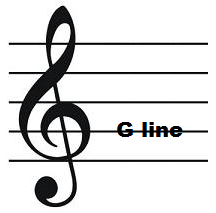This lesson is all about music note names. In particular, we will learn first of all the names of notes on the musical staff. Secondly, we will learn the notes that correspond to the keys of the piano keyboard. Thirdly, we will learn the length/value of different notes and their symbols.
Names of Notes On Musical Staff
We will start with the notes of the musical staff. Music is written on a staff consisting of five lines and four spaces. The lines and spaces are named after the first seven letters of the alphabet, namely, A B C D E F G.
My #1 Recommendation: Go here to learn about the BEST piano/keyboard course I’ve seen online.
Here’s an image of a treble clef. It is also known as the G clef. The second line of the treble clef is known as the G line. Many people call this clef the G clef because of the fact that it circles the G line.
Let’s take a look at the music note names for the lines of the treble clef. They are E G B D F. An easy way to remember this is with the phrase Every Good Boy Does Fine. The diagram below shows you the names of the lines in the treble clef.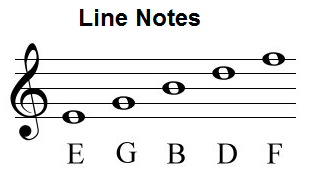
We move now to the letter names of the spaces of the treble clef. They are F A C E. This one is easier to remember because it spells the word, “face”. The diagram below clearly shows the names of the spaces in the treble clef.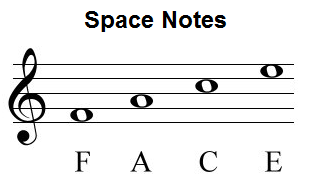
Here are the notes of the lines and the spaces:
The Bass Clef:
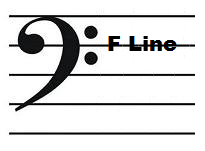 And now for the bass clef. There’s an image of the bass clef below. It’s also known as the F clef. The fourth line of this clef is the F line. Many people call this clef the F clef because of the fact that there are two dots on either side of the F line. All other note names are figured out from this line.
And now for the bass clef. There’s an image of the bass clef below. It’s also known as the F clef. The fourth line of this clef is the F line. Many people call this clef the F clef because of the fact that there are two dots on either side of the F line. All other note names are figured out from this line.
The names of the lines on the bass clef from lowest to highest are G B D F A. These letters may be remembers by using the phrase Good Boys Do Fine Always.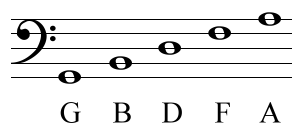
How about the spaces? The spaces of the bass clef are named A C E G. To remember these notes, try the phrase, All Cars Eat Gas.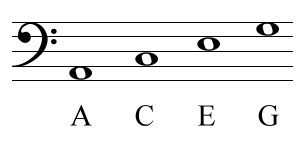
Ledger Lines
What happens when we run out of lines and spaces? What happens if we want to play a note which is higher or lower than the notes presented above? We use what is known as a ledger line (leger line). Ledger lines are short lines placed above and below the staff. The diagram below shows some examples of leger lines. 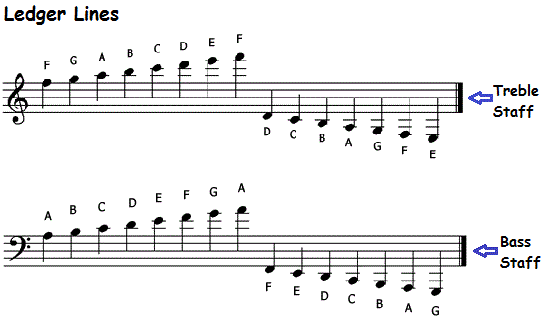
In music notation, the treble and bass clefs are often combined with an added leger line, middle C. This creates what is known as a grand staff. The treble and bass staves are joined together by a perpendicular line and bracket called a brace. 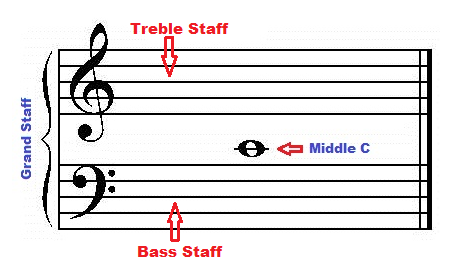
Accidentals
Notes can be either natural, sharp, or flat. The musical alphabet as we’ve seen is made up of the letters A, B, C, D, E, F and G. But any of these notes can be sharp or flat. In other words, notes on the staff can be as follows: Ab, A, A#, Bb, B, B#, Cb, C, C#, Db, D, D#, Eb, E, E#, Fb, F, F#, Gb, G, and G#. “b” stands for flat and “#” stands for sharp. Flat means to play the note a half step lower, while sharp means to play the note a half step higher. For instance on your keyboard or piano, D sharp is the key that is one key to the right of D while, D flat is the key that is one key to the left of D.
To make a note flat or sharp, a flat symbol or sharp symbol (respectively) is placed before the note on the musical staff. Flats and sharps are known as accidentals.
Here’s a diagram showing music note names of the treble and bass clef and where these notes are on the piano keyboard.
Piano Keyboard Note Names
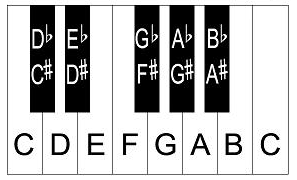 Here’s a labelled piano keyboard. It includes the notes that correspond to the white keys as well as the black keys. An easy way to know the names of the keys is by first of all observing the pattern of the black keys. The black keys follow a pattern of two black keys followed by three black keys, followed by two black keys, followed by three black keys and so on. It’s the same pattern repeating over and over.
Here’s a labelled piano keyboard. It includes the notes that correspond to the white keys as well as the black keys. An easy way to know the names of the keys is by first of all observing the pattern of the black keys. The black keys follow a pattern of two black keys followed by three black keys, followed by two black keys, followed by three black keys and so on. It’s the same pattern repeating over and over.
Every time you see a set of two black keys, the key right before it is the note, C. Once you find the note C, it’s easy to label the other keys. You can move up or down the keyboard following the musical alphabet. Every time you see a set of three black keys, the key right before it is the note, F. Middle C is close to the center of your piano or keyboard.
Music Note Names – American and British (And Their Time Values/Duration)
Let’s now take a look at different types of notes. The type of note indicates its duration. It indicates how long you are to hold the note. Each type of note has an American and British name.
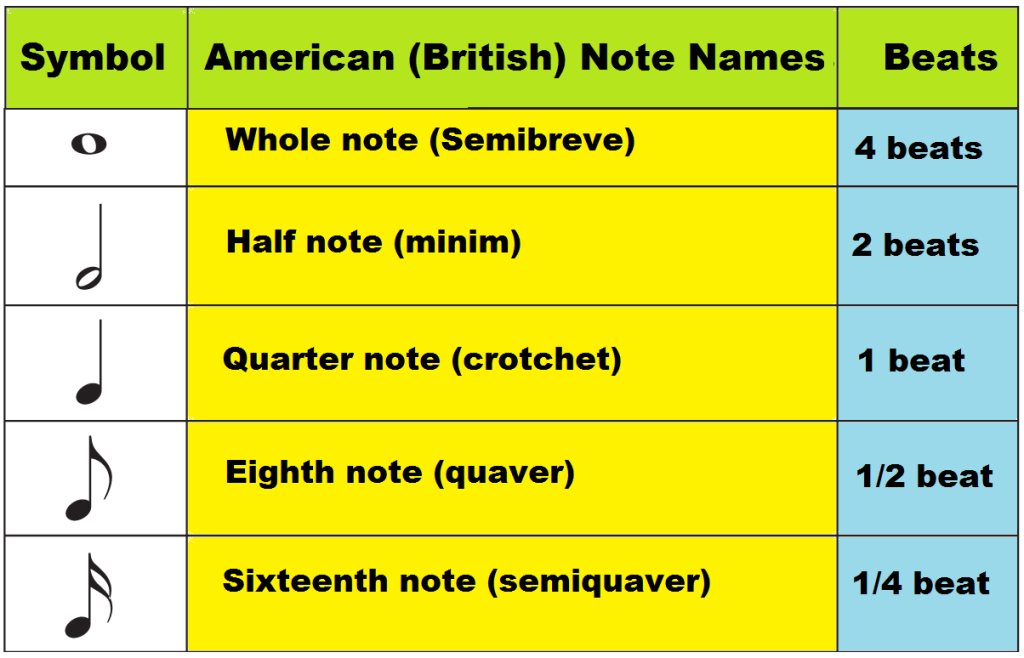
Whole Note or Semibreve
The first note we shall look at is a whole note, also called a semibreve. It has a hollow head and no stem. It lasts for a duration of four beats or counts.
Half Note or Minim
The half note is also called a minim. Its head is hollow and it has a stem. It lasts for two beats or counts.
Quarter Note or Crotchet
A quarter note or crotchet has a solid head and a stem. It has a time value of one beat or count.
Eighth Note or Quaver
An eighth note is also called a quaver has a solid head, a stem and a flag. Eighth notes can be beamed together. It lasts for half a beat and receives half a beat or count. There are two eighth notes in one beat.
Sixteenth Note or Semiquaver
The British name for a sixteenth note is semiquaver. Sixteenth notes may be beamed together in the same way as eighth notes. This note has a solid head, a stem and two flags.
Other notes include the thirty second note, which has the British name Demisemiquaver. Thirty second notes have three flags and are beamed together like eighth notes and sixteenth notes.
There’s even a sixty fourth note. Its UK name is hemidemisemiquaver. Funny, right? Quite interesting name. It has four flags and is the shortest note in general notation use.
But wait. It gets even more amazing! Other music note names are the demihemidemisemiquaver (a hundred twenty-eighth note) and Demisemihemidemisemiquaver (a two hundred fifty-sixth note). Try saying this aloud. Ha!
Whole notes are the longest notes used today, but there was once a note called a double whole note or a breve. This note lasted for twice the length or a whole note or eight beats.
Go here to learn all about piano notes.
How To Play Piano and Keyboard
